The genius of 喜多川歌麿 (Kitagawa Utamaro, 1753-1806)
Into his 30s, the Japanese artist Kitagawa Utamaro experimented with various decorative applications and drawing styles for his 浮世絵 (ukiyo-e, a genre of art in the 17th through 19th century featuring every day life) woodblock print designs. After mastering a number of techniques, the then 40-year old Utamaro received his big break once he began producing prints of beautiful women.
In particular, his close-up, bust-style portraits of beauties called 大首絵 (okubi-e), in which Utamaro depicted the upper portion of women, launched the artist into stardom. The print master’s innovative and well-executed visual techniques along with his surprising compositions, imbued his art with a fresh charm that earned high praise.
Let’s see in what way the artist’s works were considered novel, by examining one of Utamaro’s well-known prints, 「ポッペンを吹く娘」 (“Young Woman Blowing a Poppin”), seen below.
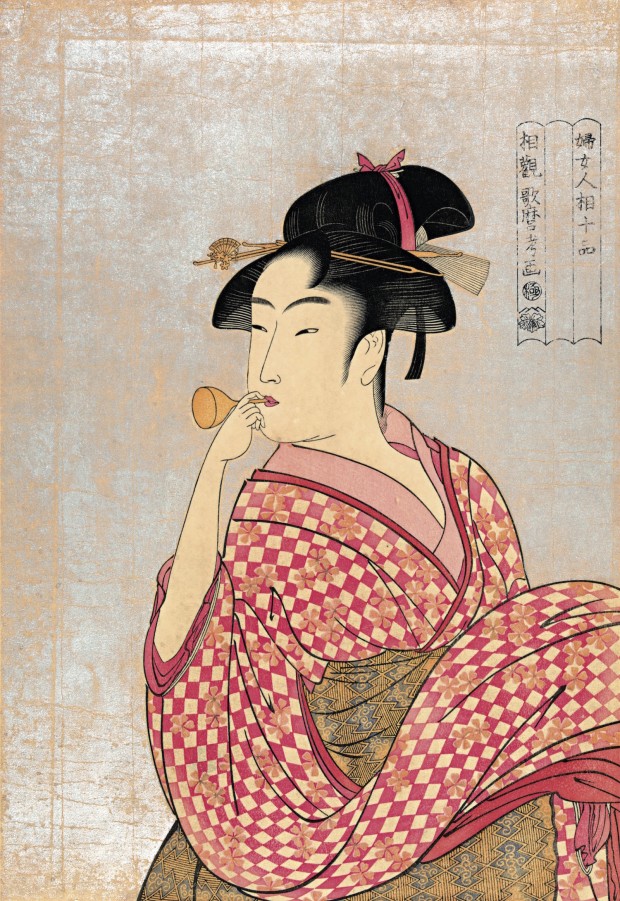 Kitagawa Utamaro’s “Young Woman Blowing a Poppin” from the series Ten Types in the Physiognomic Study of Women, oban (medium-sized) multicolored print, circa 1789-1801. Image: Alamy (PPS)
Kitagawa Utamaro’s “Young Woman Blowing a Poppin” from the series Ten Types in the Physiognomic Study of Women, oban (medium-sized) multicolored print, circa 1789-1801. Image: Alamy (PPS)
This series enjoyed immense popularity following its publishing.
What contributes to the beauty of this work?
The first thing that catches our eye is the simple background. By applying a plain, one-color background, the subject of the work stands out more conspicuously. Furthermore, the background consists of layer of powdered mica in a technique called 雲母摺 (kirazuri), which lends a brilliance to the piece. Through this technique, the range of expression in a woodblock print expands, while its impression deepens. With a different technique called 毛割 (kewari), the all-important hairstyles of women have been carefully drawn and carved one strand of hair at a time in certain areas to heighten a woman’s charm.
In addition, Utamaro’s interesting positioning of the girl in this print elongates her form and makes her appear more willowy and graceful. In this way, Utamaro preceded other ukiyo-e artists in his studies of women and knew how to best emphasize their feminine beauty in his portrayals.
Ukiyo-e captured the trends of the time!
The girl depicted in the print appears to be the daughter of an upper middle-class family, and she appears to be blowing a poppin. Blowing on one of these foreign-made glass pipes produces a popping sound, and at the time of this print’s creation, poppin or vidro (Portuguese for glass) were in vogue. By including this fashionable item that was highly coveted by the new money class of merchant townsmen, we see that Utamaro was conscious of current trends.
Another aspect that captures our attention is the model’s sumptuous clothing. The design of her 着物 (kimono) is characteristic of Utamaro’s 美人画 (bijinga, portraits of beautiful women). He often featured the newest fabric designs sold by dry-goods dealers. In the end, the popularity of Utamaro’s prints helped increase the fabrics’ sales, while his work simultaneously earned a reputation of being in vogue. In other words, Utamaro’s fashionable prints served as advertisements of sorts, too!
In this way, Utamaro’s bust-style portraits not only added to the list of technical skills that could be used in making woodblock prints, but they also expanded the realm of possibilities and effects that ukiyo-e could have in the real world. It is apparent that Utamaro’s works were monumentally important for the evolution of ukiyo-e.
Here are things to take note of in this print!
Who doesn’t enjoy some sparkle? The glamour of mica

There are two different ways to achieve the kirazuri technique in woodblock printing. One option first adds color to the background, and is then followed by a layer of glue, and finally, ground mica powder is sprinkled over the entirety or selections of the paper. The second method, which was utilized in this print, consists of mica mixed with glue being printed on the paper. Not only does the iridescent sheen of mica bestow a strong visual effect, but adhering the shimmering mineral in this manner draws attention to the subject and other items in the foreground. Mica enhances both the quality of the print and its impression of splendor.
Depicting women’s hair
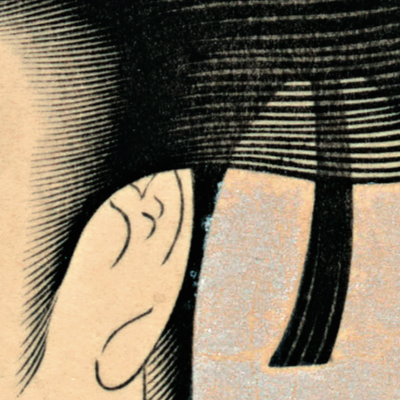
In Utamaro’s close up portraits of women, one aspect that strongly influences the picture’s impression lies in how the women’s hair appears. A lot can be understood from their fancifully arranged hairstyles, such as status, or even emotional state if the hair is tousled. An immaculate hairstyle and dark, lustrous locks would enhance a woman’s allure and emphasize the purity of her pale skin. To increase the beauty of his subjects, Utamaro was very particular about the kewari, or ratio of space between strands of hair that were carved along a woman’s hairline. This attention to detail, including the yaege technique of printing multiple layers of hair to express both movement and three-dimensional hairstyles, attest to Utamaro’s great design skills.
Why is she blowing a poppin?
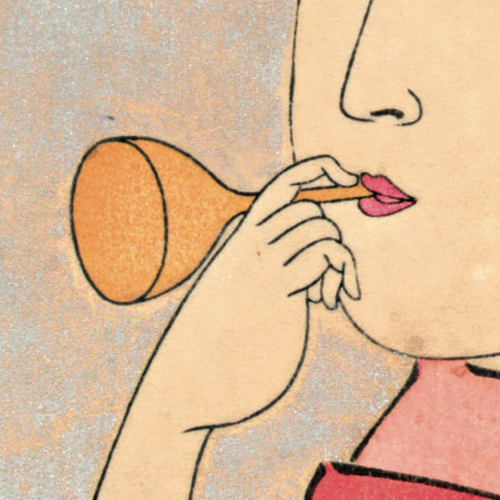
The trends of the “floating world” of 江戸 (Edo 1603-1868, present day Tokyo) were quickly caught and disseminated through the medium of woodblock prints. As a result, selecting the theme of a print or for a print series was key to its success. In “Young Woman Blowing a Poppin,” we see that Utamaro chose to feature the toy glass pipe, which were all the craze at the time. Also noteworthy is the fact that the artist’s image does not merely depict the poppin, but also demonstrates how one uses the newfangled toy.
The charismatic model’s surprising pose
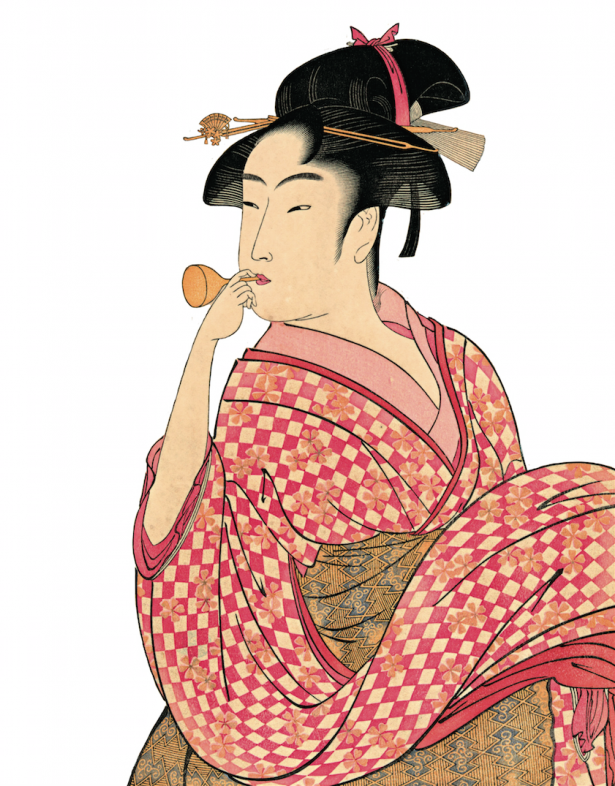
Try and mimic the woman’s pose in this print. You’ll realize that it’s neither very fun nor comfortable to imitate. Despite the tough reality of actualizing this pose, the depicted model appears very refined on paper. Only Utamaro, who had so carefully studied how to best bring out women’s beauty and capture it in two-dimensional prints, could pull off such an illusion.
Fine details create a gorgeous kimono display
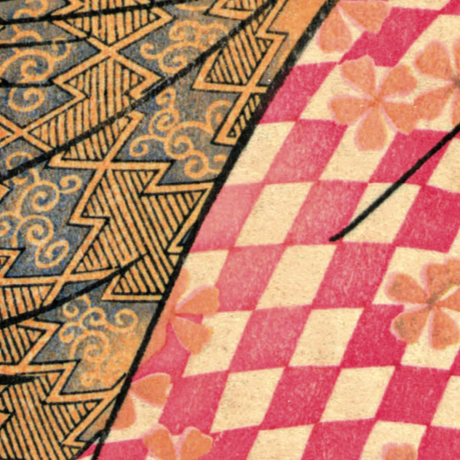
All ukiyo-e artists who produced woodblock prints in the bijinga and 役者絵 (yakushae, actor prints) genres paid special attention to their subjects’ kimono patterns. They put their everything into a kimono’s coloring. Utamaro’s kimono fabrics shone from the addition of glittery mica powder, and they had no equal.
Despite the ordinary theme of a merchant’s daughter playing with a pipe, Utamaro’s creativity found in his application of mica backgrounds, exquisite depictions of hair, and bold compositions filled his work with charisma.
Translated and adapted by Jennifer Myers.












